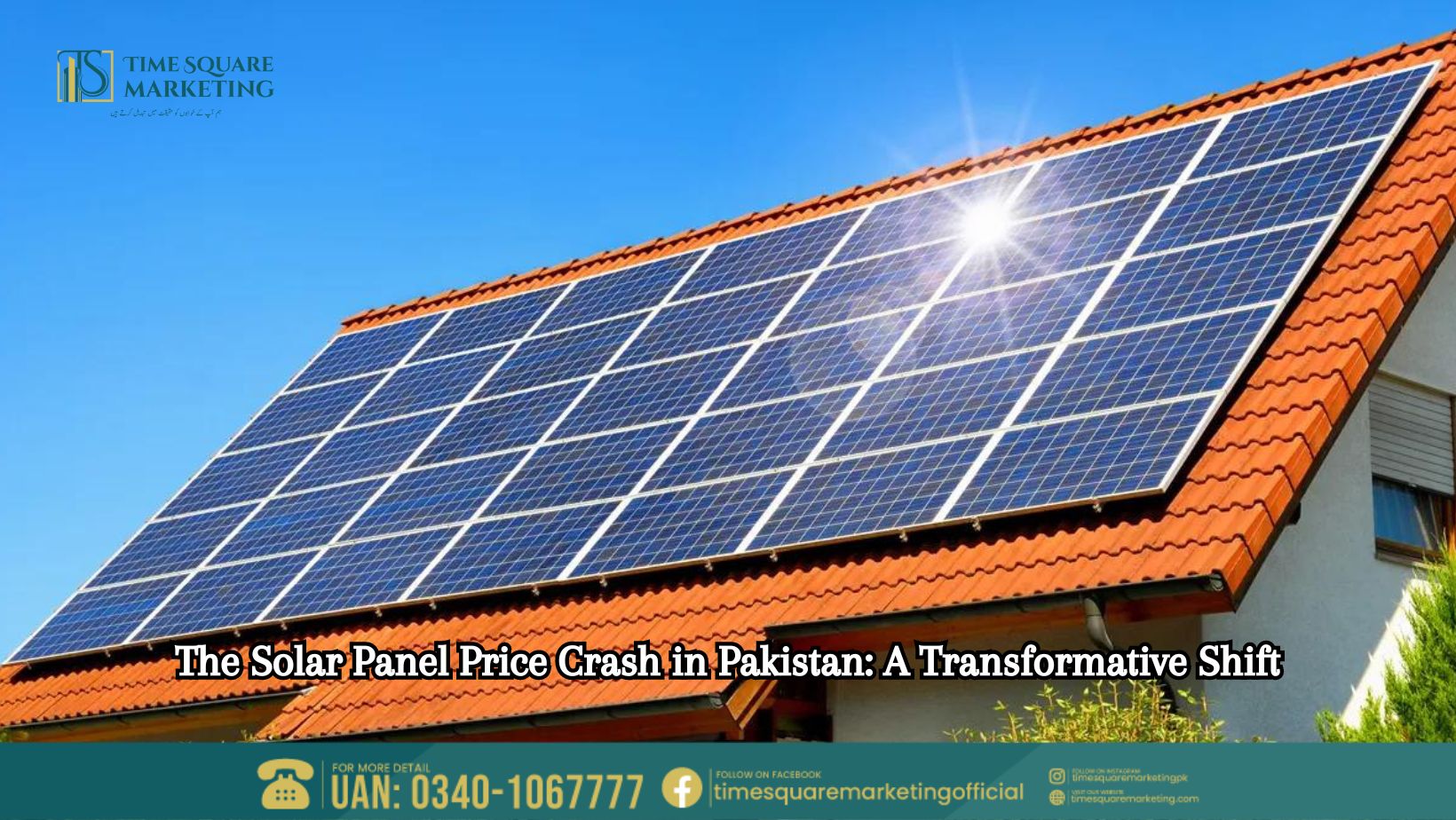In recent years, Pakistan has witnessed a significant shift in its energy landscape, largely driven by the dramatic decrease in solar panel prices. This trend, often referred to as the “solar panel price crash,” is transforming the energy sector, making renewable energy more accessible and affordable for a broader segment of the population. This blog delves into the factors behind this price decline, its impact on Pakistan’s energy market, and the broader implications for the country’s economic and environmental future.
The Decline in Solar Panel Prices: An Overview
The decline in solar panel prices is not a phenomenon unique to Pakistan. Globally, the cost of solar photovoltaic (PV) modules has plummeted over the past decade. According to the International Renewable Energy Agency (IRENA), the cost of solar PV modules has dropped by approximately 90% since 2010. This dramatic decrease is attributed to several key factors:
Technological Advancements: Continuous improvements in solar technology have significantly increased the efficiency and energy output of solar panels. Innovations in materials and manufacturing processes have reduced production costs.
Economies of Scale: As global demand for solar panels has surged, manufacturers have scaled up production. This increase in production capacity has led to lower per-unit costs, further driving down prices.
Increased Competition: The solar industry has become increasingly competitive, with numerous manufacturers entering the market. This competition has resulted in more affordable products for consumers.
Government Policies and Incentives: Many countries, including China and the United States, have implemented policies and incentives to promote renewable energy. These measures have stimulated investment in solar technology and infrastructure, contributing to lower prices.
See more: Park View City Royal Block
Pricing Breakdown: Solar Panels and Installation
Remember, solar panel prices are currently experiencing a sweet spot, ranging from Rs. 39 to Rs. 48 per watt (as of June 2024). However, the total cost of your solar system depends on several factors:
- System Size (in Kilowatts – kW): This determines how much electricity your system can generate.
- Appliance Usage: The type and duration of appliance usage significantly impact your power needs.
- Additional Costs: Installation, Balance of System (BOS) components (inverters, cables, etc.), and permits add to the final price.
Let’s Get Specific: Appliance Power Consumption
To understand your solar needs, let’s explore the typical power consumption of common appliances:
- AC: A 1-ton AC unit can consume anywhere between 800 watts and 1500 watts depending on its efficiency rating and usage duration.
- Ceiling Fan: A typical ceiling fan uses around 60-80 watts.
- LED Lights: LED bulbs are energy-efficient, with an average consumption of 5-10 watts per bulb.
You may also visit: The 10 Best Shopping Malls in Lahore
Scenario 1: Powering the Essentials (1 AC, 2 Fans, Lights)
- AC: Assuming a 1-ton AC used for 4 hours daily and considering an average consumption of 1000 watts, the daily usage would be 4 kWh (1 kW * 4 hours).
- Fans: Two ceiling fans used for 8 hours each would consume around 1.2 kWh daily (2 * 60 watts * 8 hours / 1000).
- Lights: Assuming 10 LED bulbs used for 4 hours daily, their daily consumption would be 0.2 kWh (10 * 5 watts * 4 hours / 1000).
Total Daily Power Consumption: With this basic setup, the estimated daily power consumption would be around 5.4 kWh (4 kWh + 1.2 kWh + 0.2 kWh).
Reliable System Size: To ensure sufficient power generation and account for inefficiencies, you’d likely need a system size of around 3 kW to 4 kW. This system, considering current prices, could range from Rs. 117,000 to Rs. 192,000 (3 kW * Rs. 39/watt to 4 kW * Rs. 48/watt) for just the panels. Remember, installation and BOS components will add to the final cost.
Also Visit: Pakistan’s 2024-25 Budget
Scenario 2: Expanding Your Solar Horizon
Let’s consider a scenario with additional appliances:
- Refrigerator: A mid-sized refrigerator might consume around 200 watts, translating to roughly 4.8 kWh daily if used continuously.
- Washing Machine: A typical washing machine cycle can use around 500 watts for an hour, resulting in a variable consumption depending on usage frequency.
Increased Power Needs: With these additions, your daily power consumption could rise significantly. A system size of 5 kW to 6 kW might be necessary to reliably power these appliances along with your initial setup. This would translate to a cost range of Rs. 195,000 to Rs. 288,000 (excluding installation and BOS).
Finding the Perfect Fit
Remember, these are estimates. Accurately determining your solar needs requires a detailed assessment of your specific appliance usage patterns. Consulting a reputable solar installation company is crucial for a customized system design and accurate cost estimation.
The Impact in Pakistan
In Pakistan, the solar panel price crash has had profound implications for both consumers and the energy market. Several key factors have played a role in this transformation:
Growing Awareness and Demand: As the benefits of solar energy become more widely recognized, both residential and commercial consumers in Pakistan are increasingly adopting solar technology. This growing demand has been instrumental in driving down prices.
Local Manufacturing and Import Policies: The development of local solar panel manufacturing capabilities and favorable import policies have also contributed to the price decline. By producing panels domestically and reducing import duties, Pakistan has made solar technology more accessible.
Government Initiatives: The Pakistani government has launched several initiatives to promote renewable energy, including the Alternative and Renewable Energy Policy 2019. These initiatives have provided financial incentives and streamlined regulatory processes, making it easier for consumers to invest in solar energy.
Falling Global Prices: The global decline in solar panel prices has directly benefited Pakistan. As international prices have fallen, local suppliers and consumers have been able to access more affordable products.
Benefits for Consumers
The reduced cost of solar panels has made renewable energy a viable option for a larger segment of the Pakistani population. Some of the key benefits for consumers include:
Cost Savings: One of the most significant advantages of solar energy is the potential for cost savings. By generating their own electricity, consumers can reduce or eliminate their reliance on the national grid, resulting in lower utility bills.
Energy Independence: Solar panels offer consumers greater energy independence. This is particularly important in a country like Pakistan, where power outages and load shedding are common. By generating their own electricity, consumers can ensure a more reliable power supply.
Environmental Benefits: Solar energy is a clean and renewable source of power. By adopting solar technology, consumers can reduce their carbon footprint and contribute to a more sustainable future.
Increased Property Value: Homes and businesses equipped with solar panels often see an increase in property value. Prospective buyers are attracted to the prospect of lower energy costs and sustainable living.
Economic and Environmental Impact
The widespread adoption of solar energy in Pakistan has broader economic and environmental implications.
Job Creation: The growth of the solar industry has the potential to create numerous jobs across various sectors, including manufacturing, installation, and maintenance. This can stimulate economic growth and reduce unemployment.
Energy Security: By diversifying its energy sources, Pakistan can enhance its energy security. Solar energy reduces the country’s dependence on imported fossil fuels, which are subject to price volatility and supply disruptions.
Reduction in Greenhouse Gas Emissions: Increased use of solar energy can significantly reduce greenhouse gas emissions. This is crucial for Pakistan, which is particularly vulnerable to the impacts of climate change, including extreme weather events and water scarcity.
Investment Opportunities: The solar panel price crash has created new investment opportunities in Pakistan’s renewable energy sector. Both local and international investors are increasingly looking to capitalize on the growing demand for solar technology.
Challenges and Future Outlook
While the solar panel price crash presents numerous opportunities, there are also challenges that need to be addressed to fully realize its potential.
Initial Investment Costs: Despite the decrease in prices, the initial cost of installing solar panels can still be a barrier for some consumers. Access to affordable financing options is essential to overcome this hurdle.
Grid Infrastructure: Integrating solar energy into the national grid requires modernized infrastructure. Investments in grid modernization and smart grid technologies are necessary to accommodate the increasing share of renewable energy.
Policy and Regulatory Support: Continued government support is crucial for the sustained growth of the solar industry. This includes maintaining favorable policies, providing incentives, and streamlining regulatory processes.
Public Awareness and Education: Educating the public about the benefits of solar energy and the available incentives is essential to drive adoption. Outreach programs and awareness campaigns can play a significant role in this regard.
Conclusion
The solar panel price crash in Pakistan marks a pivotal moment in the country’s energy landscape. The declining cost of solar technology has made renewable energy more accessible, offering numerous benefits for consumers, the economy, and the environment. However, realizing the full potential of this transformation requires addressing the associated challenges and ensuring continued support from all stakeholders. As Pakistan navigates this transition, the solar revolution promises a brighter, more sustainable future for the nation.









